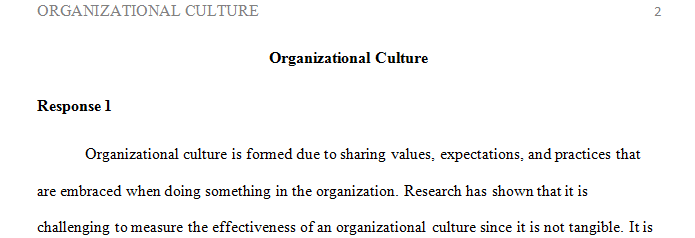Respond to two posts, each 140words
There are 2 different questions. Please reply to bothe giving 2 references for both. References can be the same! Refrences must be within 5 years only and this is due tomorrow! 1 page so 8 to ten sentences per questions.
response 1
The sharing of values, expectations, and practices make up organizational culture. Measuring how influential an organization’s culture can be tricky because culture is something you see and feel, but there are no quantitative numbers used to describe culture. Before we discussed anything further, let’s discuss the differences between qualitative and quantitative assessments.
Quantitative methods utilize multiple metrics of measurement using data analytics (Reis, n.d.). This type of measurement helps present data while measured with numbers or concrete proof. When performing a quantitative measurement, results should be able to be replicated by multiple individuals using statistical analysis (Chmolova, 2016). For example, productivity increased due to added a department-wide spreadsheet compared to when there was no one. A person studying the increase in productivity would be able to prove or disprove the claim. The Organizational Culture Inventory (OCI) (Cooke & Lafferty, 1987), a cultural assessment tool, is an additional measurement of organizational culture. These assessments include surveys, questionaries, and controlled studies to gather data to interpret.
Qualitative methods utilize assessments to determine judgment or perspective situations. A significant focus on understanding an individual’s experiences presents itself frequently in this measurement. Interviews, focus groups, and participant observation are a way to gather qualitative data. A qualitative approach general and open-ended, which allows participants to address what they are most concerned with (Steudel, 2016).
In my organization, we use qualitative methods to measure organizational culture and employee ratification with senior leadership. A command climate survey is issued every year. The purpose of the questionnaire is to gauge how effective the command is, equal opportunity, and sexual assault response and prevention (Sobeck, 2018). As a result of the findings, the creation of focus groups for every rank provides a deeper understanding of some cultural issues. The issues with this approach in my organization are that things appear not to change due to the issues identified, causing low participation and distrust of the system. From my experiences, just using qualitative methods does not work unless the organization is willing to disrupt unhealthy patterns that employees identify as an issue. A more combined approach would be more beneficial to help discern cultural norms within the organization and processes to accessing and addressing them (Nelson & Quick, 2019, p. 284).
response 2
Organizational culture defines the proper way to behave within the organization. You understand the organization’s values, goals, and ways of being. A great culture exemplifies positive traits that lead to improved performance, while a dysfunctional company culture brings out qualities that can hinder even the most successful. The distinction between quantitative and qualitative research methods occurs on two levels. It is used to distinguish between different types of date or evidence. Qualitative date are words collected through interviews, focus groups, participant, observation, or related methods. Quantitative data are numbers collected through surveys or other measurement techniques. (Yauch & Steudel, 2003). Qualitative assessments of organizational culture can be accomplished through document review, participants observation, and group interviews. The primary purpose of this is to understand the unique aspects of the organization by asking them to explain the meaning to them on various culture throughout the company. A quantitative assessment can be accomplished by administering random surveys to employees. The surveys can serve as an unbiased view of the company without being influenced by a group discussion. The primary strength of qualitative approach to culture methods is the ability to probe for underlying values, beliefs, and assumptions. Quantitative methods can be used to investigate artifacts or values but not assumptions (Yauch & Steudel, 2003). I believe qualitative approach provides more meaningful information. Qualitative gives you insight about what a specific culture is with its values and beliefs. Qualitative research can be expressed in words. You can understand the concepts and thoughts. When interviewing you can use open-ended questions, observations, etc.
Image preview for”in my organization, we use qualitative methods to measure organizational culture and employee ratification with senior leadership.”
APA
354 words

